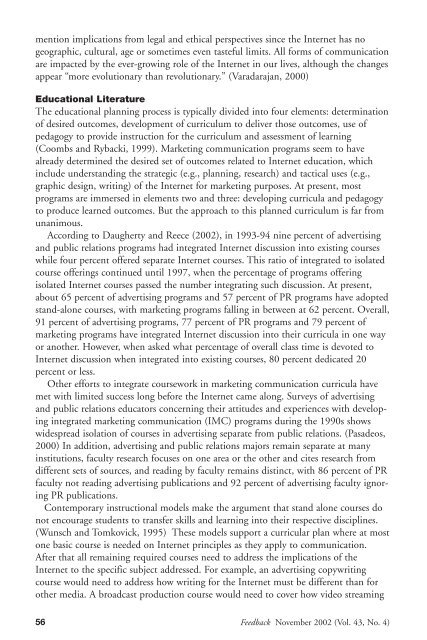Feedback November 2002 (Vol 43 No 4)
Feedback November 2002 (Vol. 43, No. 4) - Broadcast Education ...
Feedback November 2002 (Vol. 43, No. 4) - Broadcast Education ...
Create successful ePaper yourself
Turn your PDF publications into a flip-book with our unique Google optimized e-Paper software.
mention implications from legal and ethical perspectives since the Internet has nogeographic, cultural, age or sometimes even tasteful limits. All forms of communicationare impacted by the ever-growing role of the Internet in our lives, although the changesappear “more evolutionary than revolutionary.” (Varadarajan, 2000)Educational LiteratureThe educational planning process is typically divided into four elements: determinationof desired outcomes, development of curriculum to deliver those outcomes, use ofpedagogy to provide instruction for the curriculum and assessment of learning(Coombs and Rybacki, 1999). Marketing communication programs seem to havealready determined the desired set of outcomes related to Internet education, whichinclude understanding the strategic (e.g., planning, research) and tactical uses (e.g.,graphic design, writing) of the Internet for marketing purposes. At present, mostprograms are immersed in elements two and three: developing curricula and pedagogyto produce learned outcomes. But the approach to this planned curriculum is far fromunanimous.According to Daugherty and Reece (<strong>2002</strong>), in 1993-94 nine percent of advertisingand public relations programs had integrated Internet discussion into existing courseswhile four percent offered separate Internet courses. This ratio of integrated to isolatedcourse offerings continued until 1997, when the percentage of programs offeringisolated Internet courses passed the number integrating such discussion. At present,about 65 percent of advertising programs and 57 percent of PR programs have adoptedstand-alone courses, with marketing programs falling in between at 62 percent. Overall,91 percent of advertising programs, 77 percent of PR programs and 79 percent ofmarketing programs have integrated Internet discussion into their curricula in one wayor another. However, when asked what percentage of overall class time is devoted toInternet discussion when integrated into existing courses, 80 percent dedicated 20percent or less.Other efforts to integrate coursework in marketing communication curricula havemet with limited success long before the Internet came along. Surveys of advertisingand public relations educators concerning their attitudes and experiences with developingintegrated marketing communication (IMC) programs during the 1990s showswidespread isolation of courses in advertising separate from public relations. (Pasadeos,2000) In addition, advertising and public relations majors remain separate at manyinstitutions, faculty research focuses on one area or the other and cites research fromdifferent sets of sources, and reading by faculty remains distinct, with 86 percent of PRfaculty not reading advertising publications and 92 percent of advertising faculty ignoringPR publications.Contemporary instructional models make the argument that stand alone courses donot encourage students to transfer skills and learning into their respective disciplines.(Wunsch and Tomkovick, 1995) These models support a curricular plan where at mostone basic course is needed on Internet principles as they apply to communication.After that all remaining required courses need to address the implications of theInternet to the specific subject addressed. For example, an advertising copywritingcourse would need to address how writing for the Internet must be different than forother media. A broadcast production course would need to cover how video streaming56<strong>Feedback</strong> <strong><strong>No</strong>vember</strong> <strong>2002</strong> (<strong>Vol</strong>. <strong>43</strong>, <strong>No</strong>. 4)
















